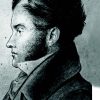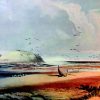Jeffcott Street, which begins atop Montefiore Hill in Adelaide and heads in a northerly direction through and around Wellington Square, is named after one of the appointees of the South Australian Colonization Commission, Sir John William Jeffcott, the first Colonial Judge of the Supreme Court of South Australia.
Jeffcott was not one of the radical insiders who were proponents of the colonising scheme and was hardly known to any of the Street Naming Committee. Indeed he only arrived in the colony just four weeks before they gathered. Being an appointment of the Colonial Office, Jeffcott was aligned with Governor John Hindmarsh and by association Thomas Bewes Strangways in this process. Being of such a persuasive manner, he managed to get his own name put forward in company with that of his patron, Daniel O’Connell MP, and his son Maurice O’Connell MP, with whom he studied at Trinity College in Dublin.
Judge Sir John William Jeffcott was the eldest son of William Jeffcott, a merchant from Tralee in County Kerry, Ireland, where the family had been in business and farming since coming over from Northampton, Warwick and Worcester in the sixteenth and seventeenth centuries. His mother, Harriet Jane (nee Hoare), was an Irish heiress. The Jeffcott family acceded to the status of Irish aristocracy by the marriage of Jeffcott’s grandfather to a granddaughter of the Knight of Kerry. Some of the family also settled on the Isle of Man.
John’s childhood passed almost unnoticed except for his occasional dalliance with poetry, which no doubt sprang from the education in classics he received under Mr Ardagh, his private teacher. His father died when he was only 11. Although his mother was left a moderate income, she soon dissipated what remained in attempting to maintain her life of earlier times. One can only speculate that much of John’s character, which was later to manifest itself so flamboyantly, probably evolved from these crucial times in his formative development. On 2 January 1815 he matriculated from Trinity College as an 18-year-old.
Jeffcott was in a word a ‘challenging’ young man. To describe him in a sentence, he was egotistical, petulant, eloquent to the point of obfuscation, persuasive and mildly erratic. In 1821 he graduated with a Bachelor of Arts. A Master degree followed in 1825. It is rumoured he was called to the Bar in Dublin, but following some time on the continent and in West Indies he was admitted to the Middle Temple in June 1822 and finally called to the Bar in London on 10 February 1826. As a member of the Home Circuit by 1829 he was listed at 16 Parliament Street, with commitments to the Midland Court.
Jeffcott’s classical education and law qualifications had not come with a commensurate bank balance, throwing him onto his limited resources, which probably explains his frenzied, repeated and mostly failed attempts to gain office in some of Britain’s dependencies; his travels abroad and his keen eye for ‘half a chance’ no doubt prompting him to do so. His repeated letters of application and indefatigable persistence paid off when he was eventually granted an appointment as Chief Justice of Sierra Leone and the Gambia.
As could reasonably be expected, given the trying climatic and miasmic environmental conditions in what had become known as ‘The White Man’s Grave’, Jeffcott did succumb like most of his predecessors to disease and contracted a debilitating tapeworm. This slowed him down somewhat and he sought premature leave to return to England. He was refused – basically on the pretext that he had not served the mandatory two years necessary before such leave would normally be granted for a Chief Justice. Reluctantly, he continued to mete out justice where needed. Throughout 1831 he distinguished himself to the extent that the Lieutenant Governors of both Sierra Leone and the Gambia praised him for his competence and diligence in the carriage of the law.
Jeffcott’s two years of service concluded in April 1832 when he immediately hastened to England. He was warmly received at the Colonial Office and any minor infractions in his performance were immediately put aside. Basking in the afterglow – and being one who never let an opportunity go begging – he very soon afterwards penned a clever letter to Lord Goderich at the Colonial Office, seeking an ‘exchange to some new colony, where I might be enabled to enjoy the society of one from whom it would give me much pain to be separated’.
He had carefully crafted a scenario where the Colonial Office was almost obliged to do his bidding. His engagement to the daughter of Colonel John MacDonald of Exeter and his continuing illness were working in his favour. He immediately sought another six months leave in support of his application, with medical testimony from Mr Thomas Davies, one of the surgeons to the King. The Colonial Office granted him three months. When he tested their patience again by seeking a further three months he was called in by Secretary Hay, who threatened and cajoled him into returning, but not, it must be said, before Jeffcott had extracted some concessions. With typical panache he argued a case in which he reluctantly agreed to go back out to Sierra Leone if: (1) he could be released from his position within a few months; (2) that he be then considered for preferment to a higher posting subsequently; and most cunningly of all (3) that he be immediately recommended for the knighthood he so earnestly desired.
Hay did not commit at this point and Jeffcott departed. Meanwhile his engagement to Miss MacDonald foundered for some unknown reason. He immediately wrote to Mr Hay on 23 April 1833, pointing out he was now ready to go back out to Africa for a short time, pending a further appointment at the Cape or in the Australian colonies.
Almost with what could be described as obscene haste, arrangements were made. The next day he was knighted by King William IV and on 3 May ordered to embark on the HMS Britomart at Plymouth on Monday 6 May.
If that were not enough to raise eyebrows throughout Britain and her dependencies, in the week which followed, Jeffcott was then to provide one of the most infamous cases of legal history ever within the British judicial system. Finding that the ship had been delayed until the 11th he took a coach back to Taunton for one night and then spent the next two at a hotel in Exeter, where he dined with his friends, Charles Milford and Robert Holland. Then, ‘[l]ate in the evening when drinking brandy and smoking cigars’, Holland let it slip that Dr Hennis, a young physician in Exeter, had maligned Sir John, as he now could be called. The next morning Jeffcott penned a scathing letter to Dr Hennis, accusing him of traducing him behind his back.
On receipt of the letter, Hennis went immediately to clear the issue with Jeffcott, who he eventually found with Holland in the street. The conversation saw Jeffcott flare and accuse the doctor of being a ‘calumniating scoundrel’. Hennis replied by demanding the accusation be retracted. It wasn’t! And in those days such a refusal could still mean the resolution of a dispute by pistols at dawn. While duelling was still common in Ireland at the time, it had by now become a criminal offence in England. The duel was arranged, very appropriately it would seem, in front of the grandstand at the Haldon Hill racecourse in Devon.
When Jeffcott severely wounded Hennis, no amount of remorse or admission of petulance and stupidity could obviate the crime. The brilliant yet fractious, opportunistic but lazy Jeffcott had finally created a place in history, infamous though it is. Hennis subsequently died and warrants were issued for the arrest of Jeffcott and those acting as seconds. The seconds were rounded up and imprisoned in the Devon County Jail, but Jeffcott narrowly escaped the Exeter police when they chased him to Plymouth. He eluded their clutches and sailed for Africa on the Britomart.
The accomplices were charged with murder and tried at the Assizes in Exeter, in July 1833. They were all acquitted. Jeffcott was also charged in absentia. The case was eventually discussed in the parliament, where the issue of Sir John Jeffcott’s recall was raised. It was untenable for any government to continue to entertain an appointment where the incumbent had a criminal case that could be drawn against him. His position as Chief Justice had to be terminated and somehow he must be brought to justice. A long-time friend of the Jeffcott family, Daniel O’Connell came to his defence, declaring with a straight face that ‘a more able, kind, humane, and excellent man did not, in his opinion, exist’. For O’Connell, this, it must be said, was a guarantee of an indelible place in the streetscape of North Adelaide.
At this point Jeffcott was induced to return home and face the court by a promise that charges would not be pressed. He agreed, delivering him the rare distinction of being the only judge of the British Crown to be arraigned on a charge of murder and brought before the courts. He faced the bench, no charges were laid and he was acquitted. His judicial post was terminated and he became unemployed for two years.
In 1835, when the South Australian Colonization Commission at the Adelphi was filling appointments for the new colony in South Australia, there were three applicants who sought the role of Chief Justice. They were Daniel Wakefield (Edward Gibbon’s brother), Henry Jickling and Henry Walter Parker, a barrister from Grey’s Inn. The jockeying among the aspirants and their patrons was palpable. But the position of Chief Justice continued to lie vacant. Sir John Jeffcott then arrived at the Adelphi on 25 April 1835 declaring to the Secretary, Rowland Hill, that he had been appointed Chief Judge of South Australia and could someone please tell him the salary and whether or not he would be having a house built for him in the colony! Feathers ruffled everywhere and there were some very distorted faces. Earlier, on 19 April, the opportunist Jeffcott had written to James Stephen, noting the vacancy and asking Stephen to bring his application to the notice of Lord Glenelg. Glenelg and the Colonial Office, with strong lobbying from O’Connell, looked again at Jeffcott’s qualifications and decided he did have all the necessary prerequisites. No doubt they were reminded he had been acquitted from any criminal charges and there was nothing technically barring him from such an appointment. The issue soon became a fait accompli – despite grave misgivings and a genuine dislike of Jeffcott by some of the commissioners, the appointment went ahead.
News of Jeffcott’s appointment travelled fast and within days his creditors were chasing him all over London. Not to be outdone, he had sailed to Ostend and evaporated in Europe, from where he wrote back to Grey requesting that any calls on his purse should be directed to Messrs R & M Brown of Manchester Square. No one was paid!
With the cunning of a fox, Judge Sir John Jeffcott again redirected the scent. As the newly appointed Chief Justice he was expected to travel out to Australia on the HMS Buffalo with Governor Hindmarsh. Instead he sought permission, in writing, to proceed under his own steam. Once this was granted he secretly joined the HMS Isabella, which was taking Sir John and Lady Franklin to Van Diemen’s Land, where Franklin had been posted as Governor. Jeffcott boarded the Isabella under the cover of darkness, again to further elude those chasing him for monies owed. He was not on the ship’s passenger list at departure and there was no cabin or quarters set aside for him. He spent the entire journey sleeping at nights on John Barton Hack’s sofa in the saloon. By day he amused himself by shooting floating bottles with his pistol. He reached Van Diemen’s Land on 1 January 1837 and decided not to proceed to South Australia to take up his post. Instead he joined his Manx (from the Isle of Man), family kinsman William Kermode, then in his 60s, at the breathtakingly beautiful pastoral property known as Mona Vale.
Jeffcott spent many an idle afternoon there, riding out with Kermode’s daughter, Anne, a distant cousin of Jeffcott’s by marriage. It is little wonder in such a paradise that they soon developed an attachment. Not to be interrupted in his romantic overtures he wrote to Resident Commissioner James Hurtle Fisher in Adelaide, declaring it had been his intention to proceed with Hack to South Australia on the Isabella. However, he suggested that until there was something profitable for him to do in the new colony his time might be better spent gathering local intelligence on how the judicial officers in Van Diemen’s Land conducted business. This, he added, might take two or three months. Unsurprisingly, he was again able to turn events to suit his selfish needs. He eventually tore himself away and proceeded to Adelaide on the Africaine where he took up his office as the first Chief Judge of South Australia, four months after the proclamation of the new colony.
By this time it was late April 1837 and Jeffcott’s first task was to preside over the first court in the colony. Jeffcott was commended for the professional manner in which he conducted his court and dealt with each case brought forward in a professional manner. On matters to do with Aboriginal justice he showed from the outset that he was not going to curry favour with white settlers at the expense of the Indigenous communities.
Six weeks into the job Jeffcott again sought leave to Van Diemen’s Land. This time it was on the pretext that he needed to restock his library and personal belongings, which had all been lost when the Isabella was shipwrecked off the southern coast of Australia near Portland as she was ferrying back and forward between Adelaide and Van Diemen’s Land. Apparently they had been shipped separately sometime after his arrival in late April. A more reasonable explanation might be that his testosterone was rising and he needed to secure the hand of Anne Kermode in marriage.
Leave was granted and Judge Sir John Jeffcott stayed with the Kermodes at Mona Vale throughout the spring, deigning to return to duty in Adelaide on 10 October. He did not marry Anne Kermode during this time as planned, but the reason isn’t clear.
Back in Adelaide and by early November he was already angling to again return to Launceston. Reluctantly, Governor Hindmarsh agreed to support such an appointment.
On 21 November Council approved Jeffcott’s leave and Jickling was sworn in as acting judge. Jeffcott sailed at once for Kangaroo Island – secretly it is claimed by some, and in the company of John Hindmarsh Jnr, the Governor’s son. They hoped to pick up a passage to Van Diemen’s Land on the Hartley. There they found she was not ready to sail, so the next day they proceeded in a cutter to Encounter Bay. As luck would have it The South Australian, the spearhead of the South Australian Company fleet, was at anchor on the lee side of the bluff at Victor Harbor, awaiting departure for Tasmania under the command of Captain John Wilson Fell.
In his diary Fell reports that Jeffcott and the young Hindmarsh took up quarters on the ship. Hindmarsh, he added, was accompanying Jeffcott to Launceston so as to be ‘best man’ for Jeffcott at his pending marriage to Anne Kermode. On 8 December a heavy storm blew from the south. The South Australian broke her moorings and was blown onto the rocks near Whalers Way. No lives were lost but Jeffcott became stranded at Victor Harbor for the foreseeable future. Meanwhile, intelligence had reached Adelaide revealing that Anne Kermode had changed her mind and agreed to marry a new suitor. Whether Jeffcott ever knew this is doubtful, given the events which followed.
Stranded at Encounter Bay, both he and Hindmarsh Jnr decided to join Captain Blenkinsop, Captain Fell and about a dozen men in a reconnaissance of Lake Alexandrina through which the Murray River empties into the Southern Ocean. There was still some support, especially from Governor Hindmarsh, for the relocation of the capital to this vicinity. The concept of a large port near the embouchure of the Murray to the sea would not go away, despite Colonel Light’s insistence that the site for Adelaide was settled.
After twelve days of pleasant sightseeing around the waters of the Coorong, which is like a series of inland lakes, the more daring among the party decided they would make a run for home through the mouth. Blenkinsop called for volunteers to join him, taunting some of his own men as he did. John Hindmarsh Jnr declined and despite heavy blistering to his feet, walked back with the land party to Encounter Bay behind the sandhills. Captain Fell, not to be outdone by Blenkinsop, clambered aboard. So too did Jeffcott! He sat aft and Blenkinsop took the rudder. Stupidly they also took on extra weight in the form of whalebone vertebrae.
Successive ‘mighty rollers’ ‘descended and the boat opened like a muscle (sic)’. Captain Fell and two others survived. Blenkinsop, two of his men and Judge Sir John Jeffcott all drowned. Blenkinsop’s body was the only one found. Jeffcott’s shot belt was seen around the waist on an overlander walking down one of Adelaide’s streets sometime later. He apparently bought it from natives near the Coorong, which suggests Jeffcott’s body probably washed ashore and lay bleaching in the sun before being pillaged. His DNA now lies scattered in the sands of Ninety Mile Beach.
Vale Sir John Jeffcott: 12 December 1837.






Comments